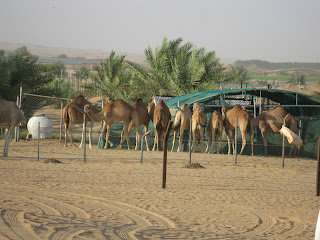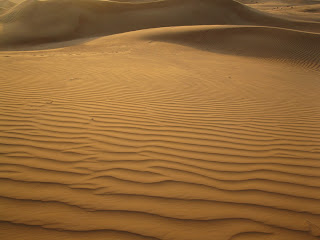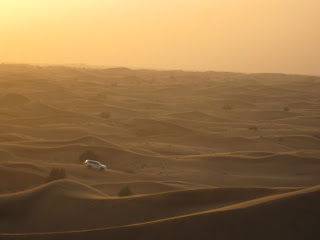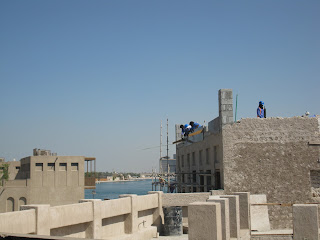Of all the paintings that I've seen, artists always depict the desert as a vast area, on flat terrain, filled with sands, one or two cactus plants, a camel and a person walking under the sun. And so, this is the image that sticks in my mind, whenever the word 'desert' is mentioned in any conversation, books or magazines.
It is a very strong image. Growing up on cartoons, art and pictures, it may have been a little distorted. I didn't realize it until I visited the desert recently.
When I first visited the desert, I didn't expect anything great. I mean, what could possibly be so impressive about a desert? Just sand and a few plants. What's so awesome about that? Fjords, mountains and caves are much more captivating than a plot of sand filled plains. Oh well, since I had nothing planned for the weekend, I gave it a shot anyway.
Nevertheless, nature always has its own way of proving someone otherwise in its most gentle mannerisms.
For one, as the little four wheel drive travelled along the desert, I began to realize that the desert is not flat! Can you believe it? It consists of little mounds of hills made from pure sand! Every few metres or so, little mound of hills (called 'dunes'), ranging in the order of one to hundreds of feet, form all over the desert! Suddenly, millions of questions rush through my brains.
"How are deserts formed?"
"Why isn't the desert flat?"
"How can the desert form, just by the sea?"
"If there's sea, there should be rain. So why does it rain only for 3-4 days in a year in Dubai?"
"How come there's not a single cactus in sight?"
"Where are the camels?"
Except for the first five questions, all were answered by the tour guide. Apparently, cactus are not the only plants that grow in the desert. In the area we visited, not a single cactus plant was in sight. The only greens that we saw were some thin, stickly, little bushes, like a miniature pine tree which grew haphazardly on the ground. And guess what? These are what camels eat! It's their staple diet.
Camels, as we found out much later, are usually reared as pets. They're not like birds or tigers or dolphins which roam around freely in the wild habitat. Instead, they're more like domestic farm animals, like cows or goats, reared for their meat and milk. In December, during winter, they're registered by their owners to participate in the annual camel race! Around Dubai alone, there are more than five camel race courses! Judging from the number of race courses, one can only guess that it is a very popular sport in the Emirates! And mind you, these race courses are not small. They are real big! Enough to form a residential area and build a world class golf course terrain.
Can you imagine a camel running? Racing side by side with another camel?
Another misconception of mine is that camels don't run. They only walk, like all camels in the movies. They walk alone in the desert, walking towards a destination which only God knows where; or they walk in single file, each herded by their caretaker, with goods between and on both sides of their humps; or with riders on their back, being a main mode of transport for the men of the ancient world. But racing? Who would have thought of that? So, one of my next desire is to watch the camel race at a real racecourse. Having never been to any sort of race, I'd love to watch one right in front of my eyes! Camels, for a start.
In Malaysia, horses which retire from racing are often dragged to the beach for a life that's easier on them. Here, instead of being forced to jump fences and run for their lives, they are just expected to plant their hoofs, one in front of the other, and carry excited little children, who wish to look at the world on a horse's back, higher than they'd ever imagine.
In Dubai, there are camels like that too! I don't know if they used to race once, but these camels certainly endure the heat and quietly follow their herder, carrying adults and children alike, who excitedly snap pictures with them, stroke them and feed them. I must say, it is a much better life than being butchered for their meat, or having their udder constantly pressed for their milk.
And did you know? It's so windy in the desert! Who would have thought that it'd be so cooling? The winds were so strong that I had to push with all my might, just to open the doors of the vehicle! And I thought in the desert, it will be burning hot!
As I stepped down onto the sand, my! oh my! The sands were so soft, that it felt like stepping on silk! So smooth, so fine and so welcoming! Instantly, I fell in love with the desert. Standing there, on the peak of one of the highest dunes, surrounded by nothing but miles and miles and millions of sand dunes, the sight is absolutely breathtaking! With the winds blowing from all four corners, felt as if I could be blown away anytime. Yet, it was a liberating experience. At that particular moment, I could have been swept off my feet by the winds and I would not have minded a single bit.
Standing there, a thought occurred. Being in the desert, is like being in the ocean without water. You can feel the sands beneath the soles of your feet. You can feel the current of the waves, trying to move you, inch by inch. The only difference is, it's dry. You can just feel it.
And did you know that the surface of the sand is not smooth? (The artist always depicts it as smooth, even colour tone). But there are different sizes of sand grains too! They form ripples, just like sands in a channel. From there, one can determine the wind direction. And they contain different colours, in varying shades of brown too!
As we head back towards the city, the sun sets against the backdrop of my new found love. A scene of nomads, prophets and messengers walking in the desert jumps to mind. How did they know where they were heading to? There are no landmarks, no clouds. Nothing. Just a few plants scattered here and there. Save for the sun which rises from the east, and sets in the west. It's amazing how people managed to travel from one destination to another, just by using what they had. Today, we use GPS, and we still get lost! What an irony!
At the end of the journey, I was speechless. Struck by the beauty of this immense, giant land, engulfed in all its quiet magnificence.
Sands made up of varying grain sizes
Sand Dunes... Uneven Terrain
Sand Ripples
'Grazing' Camels
4 wheel drive going down d dunes! Just like a roller-coaster!
Sunset in the desert
Desert Plant
Running on the sands
Footsteps in the desert
Varying Shades of Sand
Well to quench the thirst of weary travellers























































